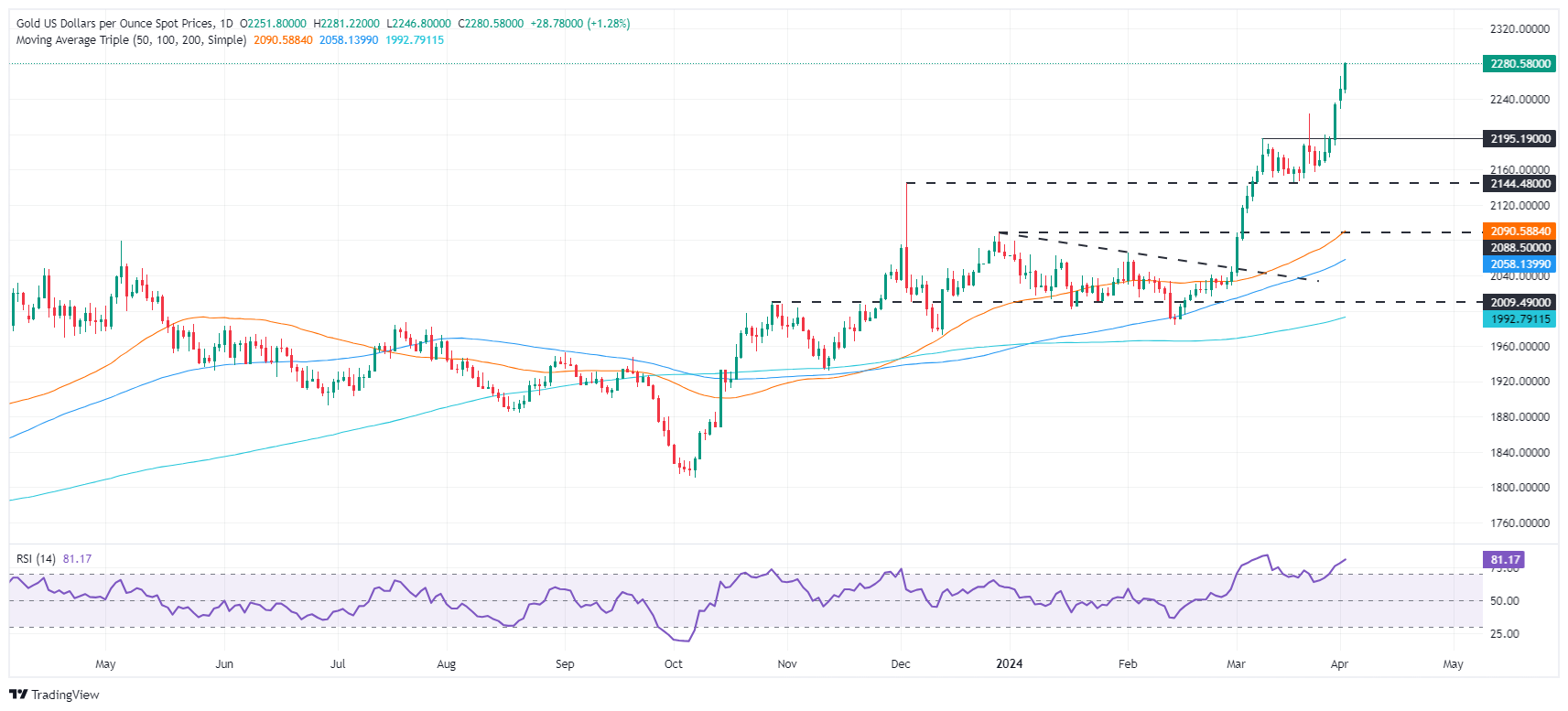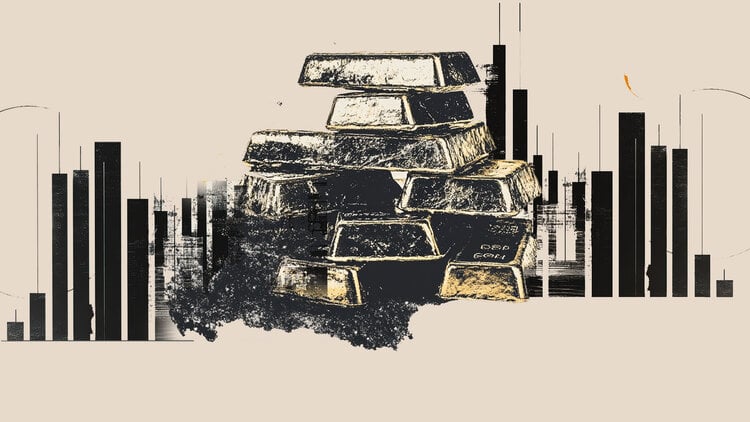- Gold rises to $2,280, boosted by tensions in the Middle East and good data from the US.
- High US Treasury yields, US Dollar strength offset by geopolitical concerns, tight labor market.
- Loreta Mester lacks information for a cut in May, but predicts three cuts in 2024, balancing inflation and employment risks.
- Mary Daly talks about the duration of rates, and supports the three cuts as a projection, not a promise.
The price of Gold rebounds to new all-time highs of $2,276 at the end of the North American session amid geopolitical risks and despite the rise in US Treasury yields. Economic data from the United States caused investors to flee towards safe-haven assets, which drove up the yellow metal. At the time of writing, the XAU/USD pair was trading at $2,280, with a gain of more than 1%.
Israel's recent attack on an Iranian embassy in Syria on April 1 helped gold rise, despite rising US yields and the strength of the US dollar on Monday. Furthermore, the US Bureau of Labor Statistics (BLS) showed that job openings increased, revealing a tight labor market, while the US Census Bureau witnessed an improvement in factory orders.
Meanwhile, Federal Reserve (Fed) officials gave statements, led by Cleveland Fed President Loretta Mester and San Francisco Fed President Mary Daly.
Daily Market Movement Summary: Gold Price Ignores Good US Data and High US Yields
- The February JOLTS job opening summary revealed that job openings remained relatively stable. The numbers reached 8.756 million, slightly above the previous month's revised total of 8.748 million and narrowly exceeding the expected 8.75 million.
- Factory orders experienced 1.4% growth in February, recovering from the -3.4% drop in January and exceeding forecasts for a 1% increase.
- The Cleveland Fed's Loretta Mester said she doesn't have enough information for a rate cut at the May meeting, although she expects three rate cuts in 2024. Mester added that the Fed's challenge will be to balance the risks between inflation and employment. .
- San Francisco Fed President Mary Daly said the Fed needs to see how long to keep rates at current levels. She supports three rate cuts, but added that is a projection, not a promise.
- On Friday, Fed Chair Jerome Powell responded to the latest inflation data, stating that it was in line with his expectations and indicating that the Fed would not overreact to these numbers. This suggests that the US central bank would remain wait-and-see regarding future monetary policy decisions.
- As for future Federal Reserve interest rate movements, CME's FedWatch tool indicates that traders currently assign a 58% probability to the prospect of the US central bank reducing borrowing costs.
Technical Analysis: Gold rally extends despite RSI overbought

The daily chart of XAU/USD suggests that the yellow metal is heading towards the $2,300 figure, amid renewed buying pressures seen in the relative strength index (RSI). On Monday, I mentioned that “XAU/USD daily chart shows Gold's latest rally to new all-time highs, achieved with lower momentum, as shown by the Relative Strength Index (RSI)” However, at the time of writing , the RSI has surpassed the 80.00 threshold, an indication that the buyers are in charge.
With the price action in uncharted territory, the next resistance level would be the $2,300 level, followed by the psychological figure of $2,350. The next level would be $2,400.
On the other hand, if the XAU/USD pair falls below $2,250, a correction could occur. The first support would be the $2,200 figure, followed by the March 8 high turned into support at $2,195, before extending its losses to $2,150.
Frequently asked questions about Gold
Gold has played a key role in human history as it has been widely used as a store of value and medium of exchange. Today, aside from its brilliance and use for jewelry, the precious metal is considered a safe-haven asset, meaning it is considered a good investment in turbulent times. Gold is also considered a hedge against inflation and currency depreciation, as it is not dependent on any issuer or government.
Central banks are the largest holders of Gold. In their aim to support their currencies in turbulent times, central banks tend to diversify their reserves and purchase Gold to improve the perception of strength of the economy and currency. High Gold reserves can be a source of confidence for the solvency of a country. Central banks added 1,136 tons of gold worth about $70 billion to their reserves in 2022, according to data from the World Gold Council. This is the largest annual purchase since records exist. Central banks in emerging economies such as China, India and Türkiye are rapidly increasing their gold reserves.
Gold has an inverse correlation with the US Dollar and US Treasuries, which are the main reserve and safe haven assets. When the Dollar depreciates, Gold tends to rise, allowing investors and central banks to diversify their assets in turbulent times. Gold is also inversely correlated with risk assets. A rally in the stock market tends to weaken the price of Gold, while sell-offs in riskier markets tend to favor the precious metal.
The price can move due to a wide range of factors. Geopolitical instability or fear of a deep recession can cause the price of Gold to rise rapidly due to its status as a safe haven asset. Being a non-yielding asset, Gold tends to rise with lower interest rates, while the higher cost of money usually weighs on the yellow metal. However, most of the movements depend on the behavior of the US Dollar (USD), as the asset is traded in dollars (XAU/USD). A strong Dollar tends to keep the price of Gold in check, while a weaker Dollar is likely to push up Gold prices.
Source: Fx Street
I am Joshua Winder, a senior-level journalist and editor at World Stock Market. I specialize in covering news related to the stock market and economic trends. With more than 8 years of experience in this field, I have become an expert in financial reporting.







